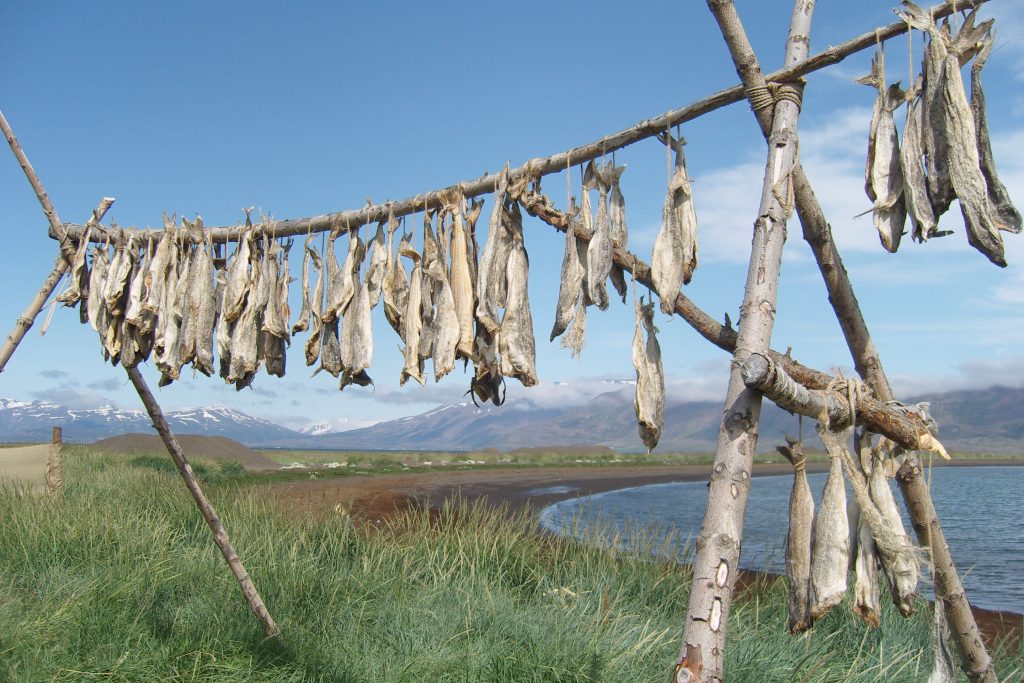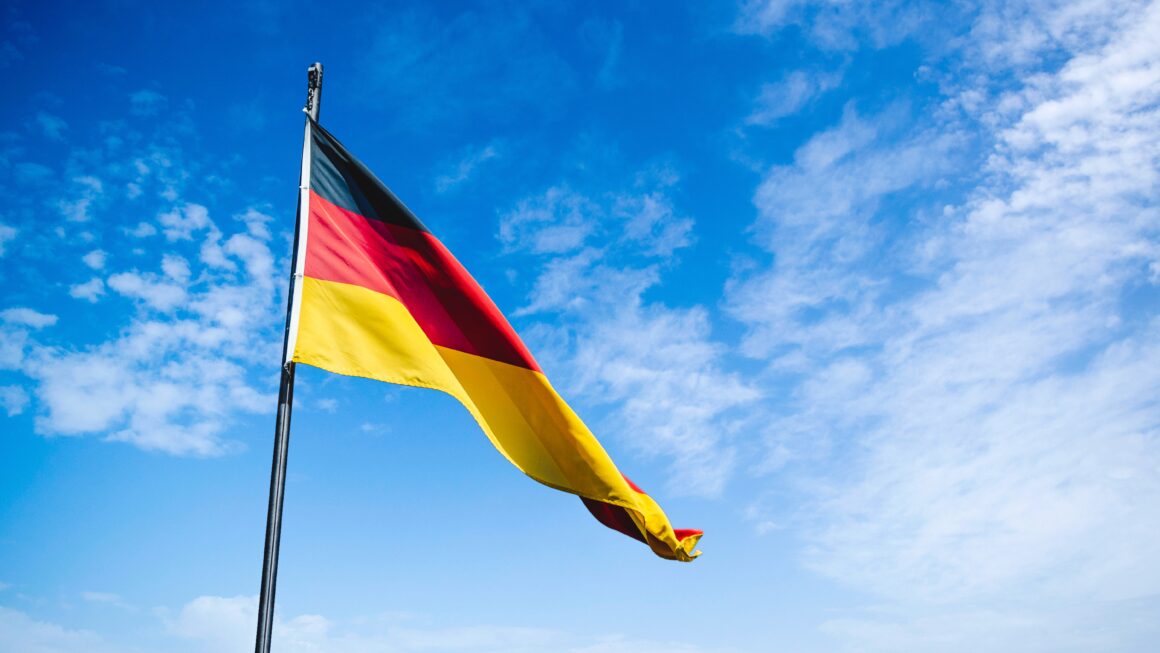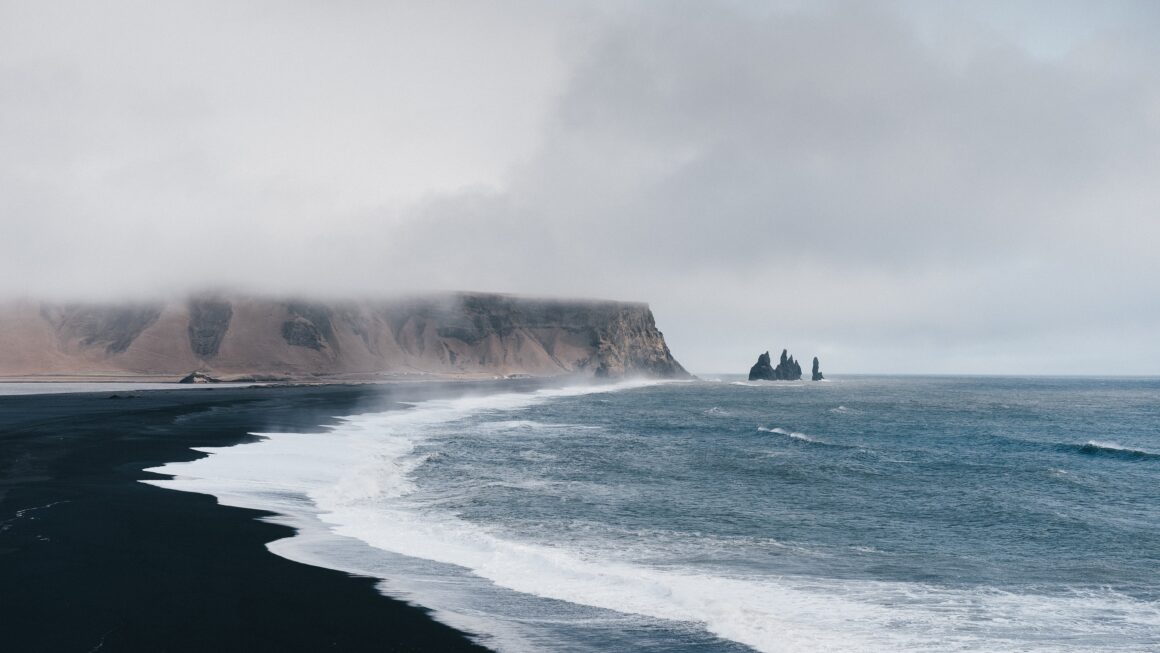This post was written in my first year at Agnes Scott, as I prepared for a Global Journeys trip to Iceland. We were tasked to write about an aspect of Icelandic culture, and a dish in particular that we were curious about. Iceland is known for many foods, some of which I tried on the trip, including their hot dog made with lamb, salted fish mentioned in this post, fermented shark and even whale (I did try all these but the latter). Icelandic salted fish in particular helps to tell the history of Iceland, which had relied on its fishing industry for generations, prior to its tourist boom. This post was revised after it was written to reflect the trip occuring in the past, in 2018.
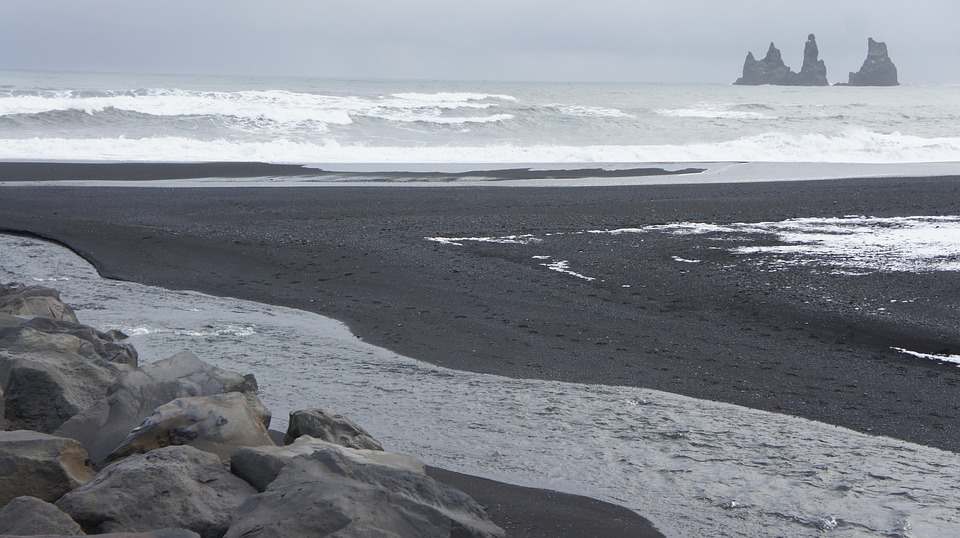
The southern Icelandic coastline at Vik, with black sand beach and waves. I went to Vik in the spring with Agnes Scott, though it was in a snowstorm and we did not walk the beach.
2017. Retrieved December 10, 2018 (http://pixabay.com/en/iceland-black-beach-black-sand-2878043/).
Food in Iceland
Food is a facet of cultural identity (Mustafa and Welsh). At my Global Journeys destination, Iceland, cuisine has been shaped by its climate, relative geographic isolation and settler population for over a thousand years. There is no single national dish of Iceland, but rather an assortment of traditional dishes, which are now also influenced by global ingredients. Traditional Icelandic foods include skyr (a kind of yogurt), lamb, fermented shark, baked goods like rye bread, and harðfiskur, or ‘hard fish,’ more commonly known as stockfish, which I will be exploring.
Inspired by Iceland. 2018. “The A-Ö of Iceland: Icelandic Food.” Retrieved December 10, 2018 (http://youtu.be/roKYl9saz3w).
Why Eat Salted or Hard Fish?
Two staple and ancient methods of preserving food such as meat and fish are drying and salting. I know salted dish personally from my Jamaican heritage, and I grew up eating ackee and saltfish, the national food of Jamaica. I was intrigued to learn saltfish and preserved fish is originated in Europe and the Mediterranean. The fish made its way to countries like Jamaica as an economic good, traded from Iceland and Europe to the Caribbean in the transatlantic trade, where it was incorporated into regional cuisine as a cheap and protein dense food food for slaves (Quammie).
Unlike saltfish, before Global 101 at Agnes Scott, where we study “Food as a Global Issue,” I had never heard of plain, hard stockfish but in my research about Iceland I found out that it is widely known as Iceland’s favorite snack (Moore). Saltfish and stockfish are most often made of cod, or haddock or wolffish (Karlsson, Kristinsson, and Matthíasson). Icelanders treat stockfish as an everyday snack, it is considered very healthy and it is high in protein and omega-3s. To prepare, stockfish dries in the wind, and like Icelandic fermented shark, takes about six months to complete preparation.
The preparation of traditionally salted or dried Icelandic fish.
Hafdal, Gunnar. 2009. Dryfish Iceland. Retrieved December 10, 2018. (https://commons.wikimedia.org/wiki/File:Dryfish_Iceland.jpg).
The Cultural Dimensions of Stockfish
The people who first populated Iceland were Norwegian, not Vikings, and Scandinavian and Irish people (Archer). They brought with them their methods of food preparation over a thousand years ago, and hunted or scavenged their diet. As Iceland was ruled by the Norwegians, Swedish and Danish throughout its history, the cuisine of Iceland was shaped by its inhabitants, and their traditional tastes, preferences and preparation methods. Eating stockfish was and is popular in Norway, Sweden and Ireland, and is eaten softened and flavored with salted butter in Iceland.
Additionally, Iceland has an extremely homogenous population, and so the traditions have not changed expect to modernize traditional processes. For example, fish was historically dried outdoors by natural elements, but now is dried with electric heaters, sometimes indoors to prevent bacterial contamination.
Economics and the Fishing Industry
The global food system is shaped by politics and geopolitical relationships, science and technology, sociocultural issues and environmental impacts, alongside global actors and local interest groups.¹ The fishing industry was one of the first trades and businesses founded on Iceland, alongside agriculture. Entire coastal towns in Iceland formed around the fishing industry, including the capital city, Reykjavik on Iceland’s eastern coast.
¹Jackson, Regine. 2018. “The Global Food System” [Powerpoint slides]. Retrieved from https://courses.agnesscott.edu/pluginfile.php/273654/mod_resource/content/2/The%20Global%20Food%20System%20%28Jackson%202018%29.pdf
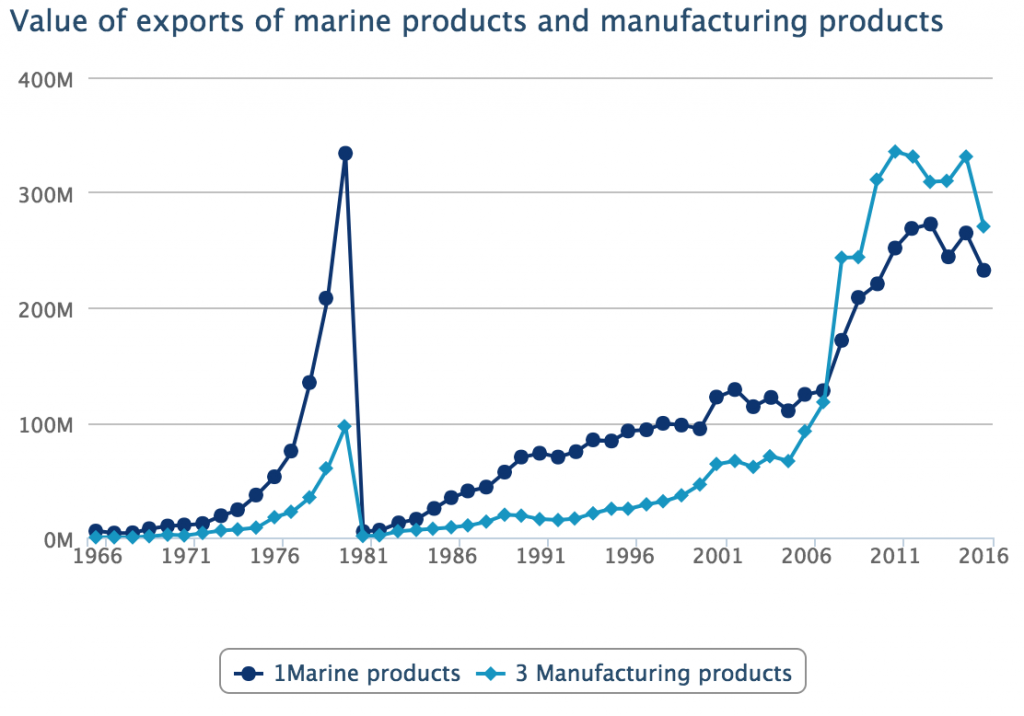
Today, one-third of Iceland’s economy relies on “catching and processing fish” (Smale). Iceland’s dedication to the marine economy and rising profile as a tourist destination has helped it overcome the “credit crunch” and depreciation of 2008 (Karlsson, Kristinsson, and Matthíasson). However, the influx of foreigners has led to “nouveau cuisine” and fast food gaining popularity and profit in Iceland (Moore). Iceland maintains their environmental values, culinary tradition and economic staple by fishing responsibly, using all biomaterial in fish processing and sharing their national foods with tourists and the global market.
Statistics Iceland. 2018. “Trade in Goods.” Retrieved December 10, 2018 (http://www.statice.is/statistics/economy/external-trade/trade-in-goods/)
Fishing and the Environment
Overfishing and fishery depletion concerns have led Iceland to diversify their economy and export trade into the “technology, renewable energy and tourism” sectors (Partington). As an island, Iceland is surrounded by water and has a natural proliferation of marine life. Iceland has fished in Norwegian and Canadian waters, and while it has not been for stockfish, this has caused tensions between countries who want to use the same fishery distribution. Environmental concerns about overfishing, North Atlantic fishing negotiations and desire to “minimize cost and maximize revenues” has led Iceland’s governmental ministries to take steps to limit and manage catch sizes, through vessel and catch quotas (Ministry of Industries and Innovation). Iceland’s fishing remains a highly profitable industry and Iceland global producer despite diversification and global fast food trends.
References:
Archer, Bert. 2018. “In Iceland, Food is a Challenge, Not a Meal.” BBC. Retrieved December 10, 2018 (http://www.bbc.com/travel/story/20180117-in-iceland-food-is-a-challenge-not-a-meal).
Karlsson, Gunnar, Valdimar Kristinsson, and Björn Matthíasson. 2018. “Iceland.” Encyclopaedia Britannica. December 10, 2018
(http://www.britannica.com/place/Iceland).
Koc, Mustafa and Jennifer Welsh. 2002. “Food, Identity, and the Immigrant Experience.” Canadian Diversity, 1(1):46-48.
Ministry of Industries and Innovation. 2018. “History of Fisheries.” Government Offices of Iceland. Retrieved December 10, 2018
(http://www.government.is/topics/business-and-industry/fisheries-in-iceland/history-of-fisheries/).
Moore, Victoria. 2000. “The Delights of Icelandic Cooking.” The Guardian. Retrieved December 10, 2018
(http://www.theguardian.com/lifeandstyle/2000/sep/15/foodanddrink.recipes).
Partington, Richard. 2018. “Tourists and Tech Bring Resilient Iceland Back from the Brink.” The Guardian. Retrieved December 10, 2018
(http://www.theguardian.com/world/2018/jun/16/iceland-tourists-tech-resilient-bank-from-brink-financial-crisis).
Smale, Will. 2017. “How an Icelandic Firm Became a Global Giant.” BBC. Retrieved December 10, 2018
(http://www.bbc.com/news/business-42024775).
Quammie, Bee. 2017. “Jamaica’s National Dish is an Immigrant to its Shores.” Saveur. Retrieved December 10, 2018
(http://www.saveur.com/ackee-saltfish-jamaican-national-dish-history).


